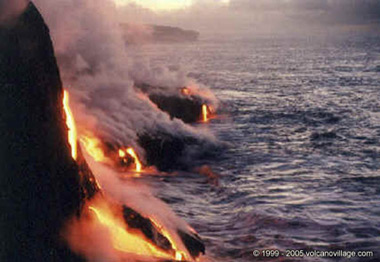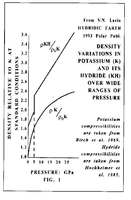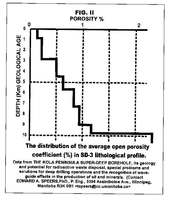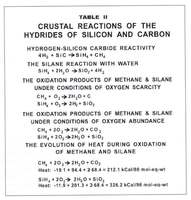Volcanism: Activity at the Hydrogen/Oxygen Interface
Volcanic activity - that's the sparks that fly and the heat that develops at the interface between the hydrogen-saturated mantle of the earth and the carapace or outer crust, where oxygen dominates. When hydrogen and oxygen meet and mix, heat is released that melts stone and results in lava. At times, a more explosive reaction involving certain gases generates great fireworks and leaves a fine ash - sometimes in thick strata - that covers the surroundings of the site of the explosion.

Mount Kilauea erupting into the sea - Image credit: Volcanovillage
Of course that is a very simplified statement of the findings of Charles Warren Hunt, author of two books: Environment of Violence and Expanding Geospheres. In a recent article titled Triple Geospheres: Oxidic Carapace: Hydridic Mantle: Ultimetal Core which was published in Frontier Perspectives, the magazine of Temple University's Center for Frontier Sciences, Hunt explains why he postulates a neat separation of two very different geospheres, and how the interaction between the dominating gases of the two spheres generates the enormous amounts of heat we observe in volcanic activity and what chemical reactions are most likely involved.
The article is an interesting read, and the theory makes sense, whereas the official view of how volcanoes are fed by a huge reservoir of liquid magma inside the earth is rather less convincing.
- - -
"The courage to imagine the otherwise is our greatest resource, adding color and suspense to all our life." - Daniel Joseph Boorstin
Triple Geospheres: Oxidic Carapace: Hydridic Mantle: Ultimetal Core
CHARLES WARREN HUNT
Suite 102, 450 Rocky Vista Gardens NW CALGARY, ALBERTA, CANADA T3G 5Y7
Abstract
This paper proposes a new theory of the Earth comprising three major geospheres - core, mantle and carapace. The junction between core and mantle is a density transition determined by geophysics. The junction of the mantle with the crustal member of the carapace is not only a density transition but also a zone of energy release, the seat of endogeny, in fact.
In this paper, hydrogen is interpreted to be present copiously in the mantle in the form of high-pressure hydrides that behave as reduced, deformable fluids in contrast to the crust, which is oxidic and rigid. Plumes of metal hydrides ascend through the mantle buoyed by lower density than their hosts. Reaching the depth/ pressure range of hydride dissociation and oxidation in the upper mantle or lower crust, they dissociate or oxidize, releasing latent chemical energy. This is the zone where magmatism, earthquakes, volcanism, and replacement mineralization occur. Rock-forming minerals of densities less than mantle minerals are deposited; isostasy is triggered.
Thusly, hydride dissociation and oxidation above a steadily degassing inner geosphere originated the lithosphere and continue to maintain it. Concurrently, atmosphere and hydrosphere evolve from non-metal hydrides that effuse from the lithosphere. Hydrogen escapes into space, leaving elemental oxygen and nitrogen to dominate the atmosphere.
At core depths, below the fluid intermetals comprising the mantle, the liquid outer core and a solid inner core may be higher-pressure phases of mixed intermetals, or they may be a new substance, a supercompressed, ultimately dense material, the "ultimetal," we might say.
New Data on Metals in the Earth's Interior
The possibility that hydrogen is abundant in the interior coupled with new understanding of the behavior of hydrogen and metals under pressure leads to a specific and unorthodox Earth structure. The Russian geologist, V.N. Larin, in his 1993 book, Hydridic Earth,1 presents laboratory results showing four successive pressure ranges with distinctly different hydride species (Table 1, Figure 1).

Figure 1 (click to enlarge)
Figure 1 shows the densification of potassium in a hydrogen atmosphere as contrasted with its compressive behavior without an atmosphere. Hydrogen in Stage I is adsorbed into crystalline metal. Metal density increases to 1.7 times original density with atmospheric pressure remaining unchanged.
Table 1THE FOUR HYDRIDE STATES
I - Covalence
H2, H2O, CH4, SiH4, NH3, etc.II - Intra-Lattice Absorption
A physical association. H atom retains electron while in metal lattice.III - Intra-Lattice Occlusion
Electron-sharing, H+ proton sheds electron within metal lattice.IV - Ionic Hydrides
H+ proton penetrates first elctron shell. High pressure, densified atom
makes "phase-changed," new substance & H, hydronium ion.
In Stage II, increasing pressure forces hydrogen to be adsorbed in the metal lattice, but still retaining its electron.
Stage III starts at a critical pressure of about 5 Gpa with density 1.95 times original density. In this stage hydrogen atoms shed their electrons to make covalent bonds with metal atoms, thus commencing the destruction of crystalline metal structure. Once again, as in Stage I, there is density increase, up to 2.3 times original density, without pressure increase.
Stage IV is the ionic hydride stage, in which hydrogen nuclei are forced inside the electron rings of the potassium metal, thus completely destroying the metallic crystalline structure. This stage commences with pressure still about 5 Gpa and continues with a linear relationship of increasing density and pressure to the limit of the equipment. Potassium density has about tripled at pressure of 29 Gpa. Of this, 33% is added hydrogen; 39% is added potassium mass; 28% is original potassium mass. The upper limit of this linear relationship is not known. But a major change should be expected at the core/ mantle boundary.
Stages III and IV hydrides have the geologically important property of fluidity. Larin showed the writer an example of this with titanium. He had set a ruby in a matrix of titanium metal, a remarkable feat, because titanium has low heat conductivity. Milling causes spalling, and for practical purposes titanium cannot be milled. Larin, however, had fluidized the titanium to a paste-like ductility by hydrogen impregnation, after which the ruby was easily embedded in the still-plastic matrix. Reduced pressure had allowed the hydrogen to escape, and the ruby was left firmly set in crystalline titanium metal.
Fluidization of metals by the injection of hydrogen nuclei has the effect of transforming the metal atoms into "intermetal." The 5-Gpa critical pressure where potassium is fluidized is approximately the pressure at the base of continental crust.
Non-metal hydrides (H20, HCl, NH4 etc.), as well as the hydrides of the transition elements, carbon and silicon (CH4, SiH4), are all characteristically fluids at much lower pressures than 5 Gpa. Whether they, like metals, also become intermetals at high pressures is uncertain to the author. What is clear, however, is that the phenomenon of nuclear injection must be a general condition for metals that occur in association with abundant hydrogen in the mantle.
Evidence for Hydrogen in Earth's Interior
This author's field research in 1986 (described in books, Environment of Violence and Expanding Geospheres 2,3) had led him to the Gros Brukkaros crater, a 3-km diameter caldera with siliceous breccia walls situated on a welt on the crystalline South African shield in Namibia. The volcano is remarkable not only because of its situation on a Precambrian shield, but also because there is a total absence of volcanic ash or tephra. Only volatiles plus the silicified breccia in the walls must have been emitted. But what gas could have been stored and hidden within the solid Earth in quantities sufficient to provide the huge flow necessary to open a 3-km vent? The author's conclusion was that, among possible gases, only hydrogen has the capability of penetrating rock fabrics so as to be effectively hidden within the Earth in quantities anywhere close to the requirements for that volcano. Hence the conclusion that hydrogen must be a major component of the inner Earth.
When writing about the African volcano, the author was unaware of Larin's hydrogen research that clearly demonstrates the potential for gas sequestration in the Earth. Thus, the concept that Gros Brukkaros was opened by hydrogen was bolstered greatly by Larin's research.
Porosity and Other Consequences of Interior Hydrides
New data supporting the idea of hydrides in the interior comes from the world's deepest drillhole, the Russian Kola Peninsula well. From a compendium of scientific data on the well, the lead author, Academician Kouznetsov,4 has kindly provided Figure II, which shows, counter-intuitively, an exponential increase of rock porosity with depth.

Figure II (click to enlarge)
Among metal hydrides in the core, silicon should dominate the mixture, as it is the third most abundant element on Earth. The low silicon density would give it a differential buoyancy among metals; and the ability to form both hydrides and oxides would make it a chemical arbiter between the reduced interior geosphere dominated by the Earth's most abundant element, hydrogen, and the exterior geosphere dominated by the second most abundant element, oxygen.
Hydrides in the core (Si + Na, K, Ca, Mg, Fe, Ti, etc.) with an average density near that of iron, being fluidic, should fractionate on the basis of relative mass and ascend as plumes through the mantle. Their mass movement within the body of the Earth would affect its rotation and explain polar wander.5 On reaching levels of decreased pressure in the upper mantle and lower crust, ionic hydrogen would escape as molecular hydrogen and molecular gases, silane (SiH4) and methane (CH4) in particular. The assorted gases would continue to rise buoyantly in the crust, permeating available porosity. Where water was encountered, silane would react, depositing silica and releasing molecular hydrogen and heat. If silane reached levels where free oxygen is present, it would react explosively, producing silica, water, and heat. These reactions generate and define endogeny, their silicon furnishing the basis for continental shields and lithosphere generally.
Appropriately in passing, the similarities and differences between the hydride gases of carbon and silicon should be noted. Methane and silane are similarly volatile, combustible, and endowed with latent heat (Table II). Two crucial differences should be noted. First, whereas silane is destroyed on first contact with water or oxygen in the crust, methane continues to migrate upward toward the surface. The second difference is that the products of combustion contrast starkly: methane only yields gases when burned (H2O and CO2); silane gives off gas and solid silica (H2O and SiO2).
The zone where high-pressured hydrides from the interior meet the oxygen-dominated rocks and water of the exterior is a battleground between very different geological regimes. Hydrides from the inner Earth are charged with energy and thus the consistent losers in the battle as metal deposits and rockforming minerals are created or transformed to lower energy states. Hydrogen is relocated from ionic to molecular forms. Heat is liberated with various levels of violence. Pressured volatiles open fractures in oxidic rock, dislocating adjacent blocks of country rock with earthquake effects. Heat released in the oxidation of ambient hydrides melts country rock to magma. Magma wells upward before crystallizing as plutons, dikes, or sills or emerging on the surface as lava.
Free hydrogen from the interior that is present in the hydride plumes is supplemented by hydrogen released in the contact zone between the geospheres. Where this hydrogen moves laterally and pervades rock adjacent to a rising plume, it densifies the pervaded rock. Densification triggers negative isostasy, regional subsidence in the form of a rift, graben, or oceanic trench.

Table II (click to enlarge)
Thus, the effects of hydride behavior at the contact between the mantle and carapace include all processes of global tectonics, volcanism, earthquakes, quiescent metasomatism, magmatism, isostatic adjustment, crustal heating, and polar wander. Where the hydrides of the inner Earth meet the oxides of the upper mantle and crust, tectonism originates and the division between the two outer geospheres of the planet is defined.
The core is recognizably different from the mantle based on density, perhaps being ultimately-compressed intermetals or a new material, an "ultimetal." The essential dichotomy of the two outer geospheres devolves from the gross chemical and physical incompatibility of hydrides and oxides. Reducing vs. oxidizing, high density vs. low density, fluidity vs. rigidity, even liveliness vs. immobility, are all stark contrasts. Life-like behavior hardly characterizes geological features, but the analogy of mobile hydrides versus rocks with their immobilized hydrogen symbolizes life-like behavior versus death-like behavior (entropy).
Returning to the porosity that increases with depth in the Kola Peninsula well, porosity is space filled with a fluid of less dense material than its surroundings. A requisite for the buoyancy of volatile hydrides from the interior is that they be less dense than their surroundings. Hydride plumes reaching the rocky upper mantle and crust pervade stress-created micro-fractures in pre-existing rock. Micro-fracturing is caused by the daily flexing of the lithosphere by tidal forces.
Within the micro-fractures, hydrides react with water and rock minerals, thus transferring mass and energy from inner to outer geosphere. Silanes in particular deliver the silicon for rock formation as well as the energy for endogeny. Mass transfer creates new crust and tends to re-seal open fractures. In this manner hydrides create and preserve the carapace above the gas-pervaded, porous underworld (a term from Greek mythology that is not inappropriate!). Increased interior porosity under the carapace is an essential feature of the dichotomy of the dual outer geospheres.
Growth of Continents
Continents must be situated above maximal hydride plume activity. They represent the thickest developments of carapace, and necessarily the most micro-fractured parts of the rocky carapace that rests on ductile mantle. Daily tidal strains open and close micro-fractures, admitting and occluding volatiles migrating from below. The author observed this in the Archean Granite 7-32-89-10 well drilled to a depth 2,368 meters (7,700 feet) into pink, charnockite granite basement in northeastern Alberta, Canada. The granite contains fluid inclusions of gases (mainly hydrocarbons) encapsulated in siliceous minerals in myriad micro-fractures.
This well only penetrated the top of the carapace, which at deeper levels should be more fractured and porous, as demonstrated in the Kola well. At still deeper levels, beneath the zone of hydride dissociation and oxidation, porosity within plumes should be high, but temperatures should decline due to absence of reactions. The deep interior of the planet, below the reaction zone where crustal heat is released in chemical reactions, may not be hot at all, but relatively cool.
Hydride reactions at the transition between inner and outer geospheres are primarily molecular hydride reactions with water. At shallower levels reactions are with free oxygen. Where silane breaks into a quiescent volcanic vent filled with air, a detonation and fiery effluence follow, the scenario reported by witnesses of the Krakatoa and Tambora volcanic events of the 19th century: an enormous explosion, a column of fire, and a rain of siliceous ash from a mushroom cloud.
Where, on the other hand, silane enters a conduit without oxygen, the silane reaction with water produces silica, heat, and hydrogen gas without the initial detonation. At the surface the hydrogen may ignite and result in a fiery eruption that is indistinguishable from the detonated eruption, a column of fire and a rain of volcanic ash from a mushroom cloud.
Large volcanic convulsions of fire, ash, and vapor appear intuitively to be too energy-intensive to be explained without a chemical reaction of combustible gas. Among combustible gases, methane, and hydrogen sulphide are widely recognized as components in volcanic eruptions. They produce heat on combustion, but not the ash that only silane can produce. The arguments for silane then are that the great blankets of siliceous ash observed worldwide require silane to explain their provenance and correspondingly large releases of energy to create them. Other metal hydrides in the silane-dominated effusion can provide the complement of minor metals found in ash and tephra, but only silane can produce the dominant silica.
The common argument against the silane explanation is that silane gas has never been detected in volcano sampling. This argument is specious because silane's explosiveness on contact with oxygen precludes its detection or recovery. On the other hand, if the worldwide blankets of ash had been exhumed from crust or mantle beneath their vents, the vents should sit in great troughs of collapse. The exact opposite is observed. Volcanic vents are usually arrayed on raised platforms in belts of volcanic mountains. Thus, energy release, siliceous ash, and detonations are prima facie evidence that silanes energize phreatic, fiery volcanism.
Atmosphere and Ocean Creation
Molecular hydrogen, water, methane, and ammonia are gases that escape into the atmosphere from the crust. In the upper atmosphere they are vulnerable to dissociation by the solar wind, whence the hydrogen fraction escapes the Earth's gravitational field. Residual oxygen and nitrogen are left to dominate the atmosphere. The carbon and some of the oxygen sooner or later are precipitated and end up as igneous or sedimentary rock on the seafloor or within the lithosphere. The copious water that escapes the crust, if not dissociated in the upper atmosphere, descends to accumulate in oceans, supplemented by cometary water from space.
A key to when the outer geosphere developed is given in the evolution of living cells. The early Archean "prokaryote" biota was only adapted to a world deficient in atmospheric oxygen. By later Archean time, to survive in the newly oxidic atmosphere and ocean, the "prokaryotes" were forced to evolve by developing the intracellular mitochondria of the subsequent "eukaryote" biota. This transition from adaptability to a reducing environment to adaptability to an oxidic environment implies that the Earth was hydridic at the surface well into Archean time and that the reducing, hydridic regime now only found in the planetary interior was the environment of original life on or near the surface.
From its inception in late Archean time, the oxidic outer geosphere has been enlarged, layer by layer, an idea first advanced by E.A. Skobelin (in Hunt et al.3). As in an archeological dig, the outer geosphere of upper mantle, crust, oceans, and atmosphere is a carapace that has grown throughout 2.5 billion years of geological time.
Summary
The proposed triple geospheres theory of the Earth is a dichotomy, a core of unknown "ultimetal," a middle geosphere (underworld) of intermetals, energy-rich hydrides, and an outer geosphere or carapace of energy-poor oxides. Hydrides are fluidic, mobile, and capable of being squeezed and forced to migrate. Fluidity allows metal hydrides to fractionate. Plumes of less dense fractions ascend upward into the oxide zone, where lesser pressures and water cause hydride dissociation and oxidation with heat emission. Magmas, lavas, pyroclastics, and granites, rocks of lesser density and greater volume than those of the underlying mantle, are created. Less-dense terranes are raised as continents above surrounding landscapes and seascapes while at the same time adjacent terranes are densified by hydrogen permeation and subside as rifts, grabens, and oceanic trenches.
The effects of hydride behavior include all processes of global tectonics, volcanism, earthquakes, quiescent metasomatism, isostatic adjustment, polar wander, and generation of crustal heat, all being forms of tectonism that originates in the transition from the hydrogen-pervaded mantle to the oxygen-dominated outer Earth. The only known contrast between the two inner geospheres is simple density, whereas the contrast between the outer two geospheres clearly involves latent energy content as well as density.
References
1. Larin, VN. 1993. Hydridic Earth. Polar Publishing: Calgary.
2. Hunt, C.W. 1990. Environment of Violence. Polar Publishing: Calgary.
3. Hunt, C. W., Collins, L.G., and Skobelin, E.A.; Ed. C.W.Hunt. 1992. Expanding Geospheres. Polar Publishing: Calgary.
4. Kouznetsov, Youri, Academician. 2000. diagram from composition in progress of: The Kola Peninsula Superdeep Borehole; its geology and potential for radioactive waste disposaI, special problems and solutions for deep drilling operations, and the recognition of waveguide effects in the production of oil and minerals.
5. James, P.M. 1994, The Tectonics of Geoid Changes. Polar Publishing: Calgary.
- - -
The Failure of Plate Tectonics
Just found in Infinite Energy magazine: A discussion by Charles Warren Hunt that may add some points to this article. CW Hunt responds to an earlier article in Infinite Energy on Plate Tectonics.
In "Beyond Plate Tectonics: 'Plate Dynamics'" author Richard Moody, Jr. tweaks the systematics of orthodox plate tectonics while maintaining its basic concept of continent-sized slabs of earth crust shifting position, colliding with adjacent huge slabs and diving into the mantle under them, a process without a power source other than heat from the planetary interior.
Plate tectonics (PT) originated from the geographical observation that the coastal profiles of South America and Africa seem to fit one another, al though the continents had been pulled apart. First proposed by Alfred Wegener in the 1920s, the crust was imagined to be made up of continent-sized slabs that "float" on a liquid layer and thus "drift" around. The idea was also rejected as a fantasy.
The matching coastlines could also be imagined as developing from a pulling apart by earth expansion (EE). (See GLOBAL EXPANSION TECTONICS by James Maxlow - Sepp) No precedent existed for this idea either, which seemed too fantastic to countenance.
Continental drift, now known as PT, was revived in the 1960s when the mid-Atlantic ridge and associated transform faults were discovered, along with compelling evidence for injection rock caused "spreading" of the walls eastward and westward, thus leaving parallel north-south trending stripes of injected rock, the youngest of which was adjacent to the injection rift and the oldest farthest from it. Another dilemma then arose: how to accommodate additional seafloor width without invoking EE, which was shunned as fanciful by PT faithful then, as now.
The PT solution to the seafloor spreading dilemma was the proposition that new crustal mass created by injection must be compensated by "subduction", the diving of ocean crust under opposing continental plates after plate collisions. Seismology obliged by attributing some layered reflections near continental margins to "plates" that were conceived to be subducting.
Why the EE explanation is shunned goes back to antiquity. Philosophers believed that physical matter must be made up of "elements", permanent tiny components from which everything else is made. In antiquity, the elements were thought to be fire, water, air, and earth. By the nineteenth century chemical elements were recognized, and 92 of them had been identified. These were regarded as the smallest components of matter, irreducible and indestructible. But that attribution was soon degraded when radioactivity among the heaviest elements proved their instability and thus, their non-elemental behavior.
Notwithstanding the inherent failing of the idea or elements, most twenty-first century scientists including PT enthusiasts, adhere to the idea that elements are the building blocks of the entire planet. On this premise the elemental count, and the volume of the earth necessarily remain constant. Earth expansion is impossible if the elementarian principle is true.
The observable geology of crustal addition on the mid-ocean ridge thus requires PT, whereby crustal components of the earth are shuffled around and some of it is "subducted" in order to compensate for the mid-ocean additions and to avoid EE.
As H.L. Mencken said, for every complicated problem there is a solution that is elegant, simple - and wrong!
That is the situation with PT, in my view. Firstly, there is little concrete evidence for subduction, especially where it is needed most, adjacent to the stripes of added crust beside the mid-ocean rift. Secondly, there is no evidence for a world wide fluid base below the continents and instead, much evidence that continental roots are deep, giving them a shape like a tooth rooted deep in the mantle, rather than a thin plate shape detached from the mantle and floating above it. Thirdly, subduction is not a mechanically sound idea because there is no conceivable source of energy that would force less-dense shallow crustal rock to sink into denser mantle rock.
Leaving, for the moment, the deficiencies of PT theory, one must ask if there is any alternative whereby new material may be added to the crust. The answer comes firm and positive from the later in the twentieth century researches of the Russian geologist Vladimir N. Larin (Hydridic Earth, 1993, Polar Publishing). Larin's repeatable laboratory experiments demonstrate that metals at mantle pressures in a hydrogen atmosphere absorb hydrogen nuclei, which transmutes them to high-density "intermetals". Intermetals are fluid forms without specific atomic mass. Abundant hydrogen must permeate the mantle and core of the planet, just as it does the rest of the universe.
All metals, and especially the transition metals silicon and carbon, occurring in the planetary interior likely exist as high-density, low-volume hydride forms. Being fluid, they have an ability to coalesce and rise as plumes into crustal levels, where reduced pressure and oxides (water) cause reversion to true metals or oxidation to deposit rock-forming minerals. The rock deposits of the crust are lesser in volume than their intermetal progenitors and therefore prove the existence of EE by their very existence.
Deposition of metals and rock-forming minerals that characterize the earth's crust elegantly show how the volume of the earth has been increased without extraneous material being added. The crust appears to be a shell deposited through geological time, an artifact of hydride destruction. The crust of the earth, its hydrosphere and its atmosphere, can be viewed as artifacts of hydride decomposition. The mantle is likely hydridic, not mainly rock. The core cannot be iron, and may be some ultimate hydride form ("ultimetal"?)
The very concept of "elements" is fallacy, because abundant ydrogen destroys metal characteristics. Whereas the inherent volatility of hydrogen had made its presence within the earth incomprehensible, and whereas it was natural that science would attribute earth composition below the crust to "elements", Larin's experiments demonstrate that the behavior described above and shine new light on the nature of the interior of the earth.
Among the profound consequences of an hydridic earth are
1) Geothermal heat may be partially primordial; as generally thought. But the heat emanating from the crust is likely largely heat generated by oxidation of intermetal hydrides at the base of the crust and within it.
2) Petroleum and natural gas result from the effusion of the hydride of carbon, methane (CH4), which bacteria and archaea attack in the upper crust, "degrading" it to petroleum and coal.
3) Metal ore deposits within the crust can be attributed mainly to de-pressurization and/or oxidation of intermetals.
4) Most earthquakes, especially deep ones, are likely the energy released by silane (SiH4) reacting with water within migratory conduits and depositing silica, which blocks oncoming hydride flow in the conduits until increased pressure from below bursts the barriers, releasing chemical energy that comprises such earthquakes.
Charles Warren Hunt
Calgary, Alberta, Canada
See also:
Polar Publishing - Books that challenge geological orthodoxy
Astronomer finds that Mercury has molten core
Margot and collaborators conducted a series of observations over five years using a novel technique to detect tiny twists in Mercury's spin as it orbits the sun. The twists, called longitudinal librations, occur as the sun's gravity exerts alternating torques on the planet's slightly asymmetrical shape. They found that the magnitude of the librations was double what would be expected for a completely solid body -- but explainable for an object whose core is molten and not forced to rotate along with its shell. Mercury is thought to consist of a silicate mantle surrounding an iron core, but because small planets like Mercury cool off rapidly, the core should have frozen long ago.
An indication that the same mechanism as postulated in this article might be at work on other planets?
Rover Finds Evidence for Volcanic Burst on Mars
NASA's Spirit rover has stumbled upon evidence of an ancient volcanic explosion at "Home Plate," a plateau of layered bedrock near the rover's landing site in Gusev Crater. The finding lends more evidence to the idea that Mars had a watery past, and marks the first explosive volcanic deposit seen by Spirit or its rover twin, Opportunity. However, scientists have long known ancient Mars was volcanic. The evidence is plain: Olympic Mons, the tallest known volcano and mountain in our solar system.





Nick Tastad says (by email):
Not that I want to out-right denounce this line of thinking, as I'm no expert in this arena, but it doesn't make sense to me. I've studied under some pretty sharp Geologists including Dr. Jorge Mattschulat of TU-Freiberg. My impression from those studies is that the magma is derived from the immense pressure and movement within the earths core. Plus, if it were more a matter of a chemical reaction, why would the core of the earth be much hotter than the outer-strata where this reaction takes place?
In any event, there is not a single doubt that vast quantities of energy are there to be harnessed from this phenomenon.
Hi Nick,
thanks for your comment on this one.
Yes, the official view does uphold that the earth's interior is glowing hot, and that volcanism derives from that. But do we really know, or is that one of those "everybody knows" things that we do not normally critically examine.
For me, it's important to keep an open mind and look at these kinds of possibilities, even if they contravene what we have studied.
And yes, you're right, there is a lot of energy to be had in this volcanic area, just for the taking....
Yes, the core of the Earth is currently assumed to be "hot as hell". Maybe it´s actually cold save hot spots of local activity.
Quite intriguing that rock porosity increases with depth.